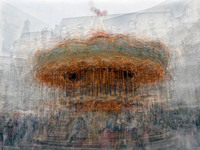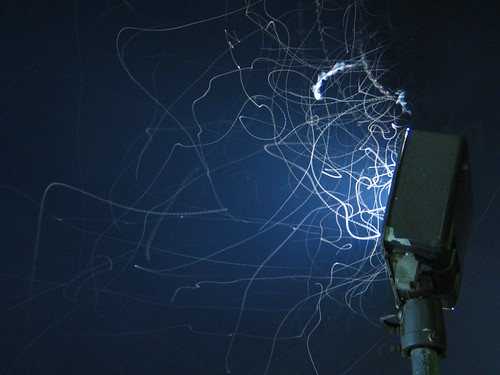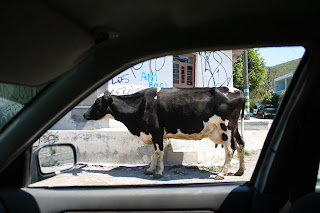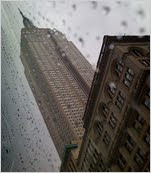
Wednesday, September 29, 2010
READING: Q & A with Robert Caplin
In this article, the NYT interviews travel photographer Robert Caplin. He talks about how to make your photos look more professional on a budget. On another note, he has some interesting ideas for iPhone cameras. He explained that the phone camera can be tricked into thinking that the light is darker than it is, which raising the camera to a source of light and then quickly taking the photo you want can compensate for. Here is one of his iPhone camera photos taken in Manhattan:


Tuesday, September 28, 2010
EXAMPLE: Fire Breathing and Shakespeare

I saw this really cool pic up on http://www.deviantart.com/ by one of my favorite photographers. It's kind of amusing because this photographer usually does high fashion, model type stuff. It's fun to see something exciting and kind of dangerous like breathing fire combined with his usual dainty model.
Currently, I'm in the process of editing some of the images from my Ashland trip. I didn't get that many because they were super prissy about copyrights (You can't even have pix of the outside of the theater because apparently that's copyrighted too). But I got some of my friends and a bit of the workshop and actor discussion. I'll post them up here when they're done.
EXAMPLE: Multiple Exposure
I love the way some photographers are using cameras and computers to combine multiple exposures into a single image. For example, Pep Vendosa, a local photographer shows examples in his garden and carousel series.
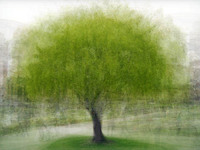
Of course this isn't completely new, cubist painters like Picasso, Gris and Braque were interested in the same ideas around the early 1900s.

Of course this isn't completely new, cubist painters like Picasso, Gris and Braque were interested in the same ideas around the early 1900s.
PROJECT 1: Alternative Process
So far I have been working with and experimenting with other ways to manipulate my photos. I worked with toning, in which I altered the color of the photograph by dying it in several different liquids. The first print was dipped into a tray filled with dark coffee, other were dipped into a tray of earl gray tea, black tea, and jasmine blossom green tea. The last print was dipped into a tray of red food coloring, resulting in a very pink photograph. I really enjoyed doing this project because I was testing new grounds and didn't know what the outcome would be. With the other three I really enjoyed the results because it gave the pictures an olden or aged look.
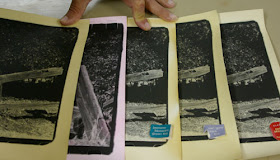

Monday, September 27, 2010
PROJECT 1: Large Format - Partial Exposures
Last week, I continued to work with the large format view camera, turning my attention to portraiture and partial exposures of film with the assistance and advice of Mr. Zivkov.
The technique we used to create the partial exposures was to take a photo of the subject while covering the bottom half of the lens with a piece of black mat card, then to remove the subject (in this case, people) and to take a photo of the same scene while covering the top half of the lens, thereby making two mini photos on a single sheet of film.
Below are the results.
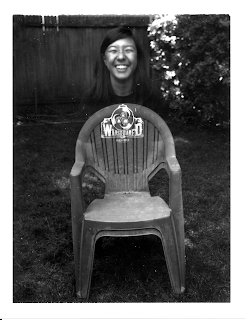
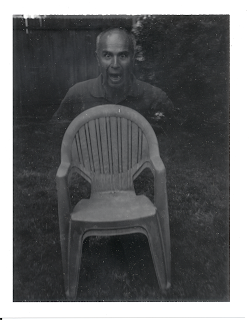
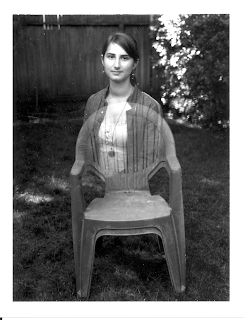
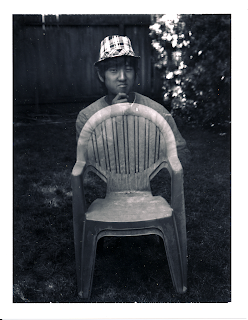
The technique we used to create the partial exposures was to take a photo of the subject while covering the bottom half of the lens with a piece of black mat card, then to remove the subject (in this case, people) and to take a photo of the same scene while covering the top half of the lens, thereby making two mini photos on a single sheet of film.
Below are the results.




PROJECT 1: Rankin vs. Platon


This rotation I have been researching two modern and emerging photographers, Rankin and Platon. Both are very well noted for their work in portraiture, especially of celebrities and world leaders.
Recently Rankin has been working on several advertisements, most notably for the world cup. Including the Africa against AIDS foundation, and Nike. His eye for poses and backgrounds are really catch the eye and never fail to amaze.
Platon has photographed everything from ordinary people, to world leaders in Russia, to Bono. His use of close up photos of wide angle lenses are truly unique and prove to be very interesting shots. Platon is most renown for his many photographs of world leaders on the cover of multiple TIME magazine.
Friday, September 24, 2010
PROJECT 1: Digital (RAW)
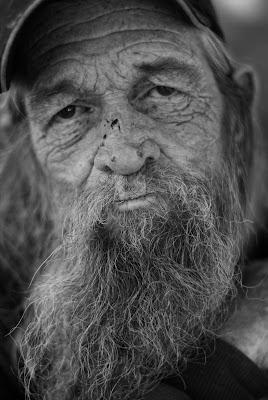
For this project I decided to photograph portraits in (RAW) format. I think that portraits are a good way to show people at their best, and I tried to bring that out in my photos. Overall, I think that people believe that portraits are easy to shoot because you're just taking a picture of someone's face. But it is a lot harder than that, you need good lighting, the person needs to feel comfortable, and you need to position the person in the portrait where they are the main focus of the picture. I tried to use all of these points to make my photos concentrate on the people in them. I found a Group of homeless guys, who were happy with what they had, and were just hanging out. They were more than happy for me to take their picture. This specific guy (Jack) by far had the most character with his beard, and the wrinkles and cuts on his face. Overall i wanted to do something abnormal to break the barrier of portraits.
Monday, September 20, 2010
READING: An Insomniac Photographer
This is an article I found a while ago about a woman who photographs NYC at night. The photographs are stunning and her explanations are thoughtful and interesting. I particularly love the Pepsi-Cola photo.
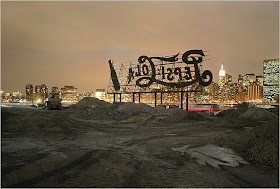

Sunday, September 19, 2010
EXAMPLE: Timelapse Video and Slow Shutter
Timelapse Montage from Mike Flores on Vimeo.
Check out the above link. I thought it was pretty epic and amazing. Kind of makes me want to do some more light painting, or long exposure stuff in general. Maybe try out moth trails?
Saturday, September 18, 2010
PROJECT 1: Large Format
We've now moved onto our second phase of projects from the initial reorientation projects. For about a month or so, I have been given the opportunity to wrestle with and conquer the view camera (or in layman's terms: The box camera with the black cloth drapey thing.)
This week, I concentrated on trying to get my bearings with this camera and to familiarize myself with how it works. A view camera is essentially the same as a regular camera, but unautomated and with its inner workings exposed instead of encased in a shiny metal shell.
So far, I have taken 2 self-developing Polaroid photos (which work essentially as test strips) and 3 photos on film. I tried to include our white balloon theme in the film photos, as well as try to experiment with people photography.
Below are the Polaroid photos (I have not yet developed the film, and so unfortunately cannot share the film photos.)
Enjoy!
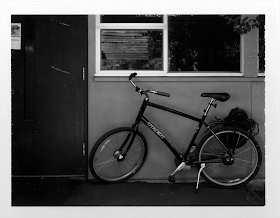
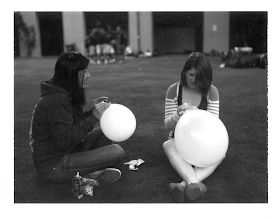
This week, I concentrated on trying to get my bearings with this camera and to familiarize myself with how it works. A view camera is essentially the same as a regular camera, but unautomated and with its inner workings exposed instead of encased in a shiny metal shell.
So far, I have taken 2 self-developing Polaroid photos (which work essentially as test strips) and 3 photos on film. I tried to include our white balloon theme in the film photos, as well as try to experiment with people photography.
Below are the Polaroid photos (I have not yet developed the film, and so unfortunately cannot share the film photos.)
Enjoy!


Thursday, September 16, 2010
PROJECT 1
Here's our first project rotation Sept 13 - Oct7
- Alternative Photography - Laura
- Large Format Camera - Kevin
- Medium Format Cameras - Anna
- Digital SLR & RAW Format - Craig
- Biography Comparing Two Photographers - Phil
- Event Photography - LeeAnne
READING: Emotional Sports Photography
At it's core, sports is about raw physical effort and intense emotions. I love how this photo conveys the friendship, respect and admiration these famous players had at the peak of their ability. Read the New York Times story to learn more about the photo and the photographer (John Varley).
Wednesday, September 15, 2010
DARKROOM PROJECT
In the first week, I worked on a number of things, namely a comparison of fiber paper versus resin-coated paper and a large photogram.
Fiber:
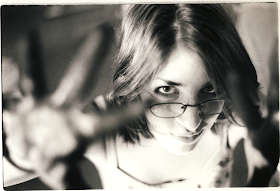
Resin-Coated
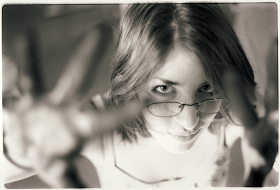
The main difference between fiber and resin-coated paper is that fiber paper gives everything a "warmer" looking color tone, in which the entire photo takes on a very subtle greyish-yellow looking tint. Resin paper in comparison has a stark cold, almost sterile-looking feel to it, where the whites and greys all have blue components.
Fiber paper also gives off much deeper dark colors, whereas dark colors on resin-coated paper appears to be more of a very very very dark grey (it has bluish hints, versus fiber paper's deep black.)
I would imagine that one would have to decide what effects are desired before choosing a paper type. Cold? Warm? Greyish? Black?
Next off is the photogram.
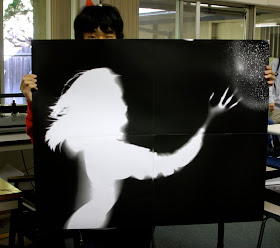
I collaborated with LeeAnne to produce a large human photogram that was 4 sheets of 20*24" resin-coated photo paper taped together. Our process involved taping the four papers together out in the safety light, then going into the film-loading darkroom and having LeeAnne lay on the floor so we could make the photogram by turning the lights on for 1 second.
To make the sparkling effect on the top corner, we used a spray bottle to apply spots of fixer before developing the photogram, which prevented the spots touched by the fixer from being developed.
Then, we separately developed each 20*24" sheet, as the large photogram would not have fit in the developing chemical trays.
All in all, I would say the first week was a pretty successful way to start off the new year with a theme of experimentation and thinking out of the box.
Below are the results of my comparison between fiber and resin-coated papers (model is the amazing Meredie Johnson).
Fiber:

Resin-Coated

The main difference between fiber and resin-coated paper is that fiber paper gives everything a "warmer" looking color tone, in which the entire photo takes on a very subtle greyish-yellow looking tint. Resin paper in comparison has a stark cold, almost sterile-looking feel to it, where the whites and greys all have blue components.
Fiber paper also gives off much deeper dark colors, whereas dark colors on resin-coated paper appears to be more of a very very very dark grey (it has bluish hints, versus fiber paper's deep black.)
I would imagine that one would have to decide what effects are desired before choosing a paper type. Cold? Warm? Greyish? Black?
Next off is the photogram.

I collaborated with LeeAnne to produce a large human photogram that was 4 sheets of 20*24" resin-coated photo paper taped together. Our process involved taping the four papers together out in the safety light, then going into the film-loading darkroom and having LeeAnne lay on the floor so we could make the photogram by turning the lights on for 1 second.
To make the sparkling effect on the top corner, we used a spray bottle to apply spots of fixer before developing the photogram, which prevented the spots touched by the fixer from being developed.
Then, we separately developed each 20*24" sheet, as the large photogram would not have fit in the developing chemical trays.
All in all, I would say the first week was a pretty successful way to start off the new year with a theme of experimentation and thinking out of the box.
DARKROOM PROJECT

In class we did a comparison between resin and fiber paper prints. The fiber paper was rougher, curled up at the edges and needed a longer exposure time. It gave the image a warmer feel, versus the glossy bright resin paper. I liked the fiber paper better.
I also made a photogram with the help of LeeAnne, combining a negative taken at the Chihuly exhibit at the DeYoung with my profile. I made a test strip using the negative to determine my exposure time.

DARKROOM PROJECT
This week I experimented with the differences between Resin Coated , and Fiber Paper. I used different exposure times under the enlarger, but used the same piece of film and level of contrast for both. I tend to prefer Resin Coated paper just because I feel like you come out with a cleaner more athletic final piece, and I also like the crumpled leaf effect after development
, and Fiber Paper. I used different exposure times under the enlarger, but used the same piece of film and level of contrast for both. I tend to prefer Resin Coated paper just because I feel like you come out with a cleaner more athletic final piece, and I also like the crumpled leaf effect after development
 , and Fiber Paper. I used different exposure times under the enlarger, but used the same piece of film and level of contrast for both. I tend to prefer Resin Coated paper just because I feel like you come out with a cleaner more athletic final piece, and I also like the crumpled leaf effect after development
, and Fiber Paper. I used different exposure times under the enlarger, but used the same piece of film and level of contrast for both. I tend to prefer Resin Coated paper just because I feel like you come out with a cleaner more athletic final piece, and I also like the crumpled leaf effect after developmentSunday, September 12, 2010
Friday, September 10, 2010
EXAMPLE: Contact Sheet Photo Art
A carefully planned grid of photos on a contact sheet can be made into an amazing image. It can be done with film or digital photos, though digital is a little more forgiving. Here are some examples.
- Strange Contact Sheet Self Portraits - Karl Baden
- Contact Sheet Word Art - Martin Wilson
DARKROOM PROJECT


Here are some photograms I did with Kevin Ji and Laura Alvarez. This first week back in the darkroom, we worked on making large photograms, printing with both RC and fiber paper, as well as printing large prints.
First off, I really enjoyed making large photograms this week. It was sort of interesting trying to figure out how to actually process them, especially the one with Laura because it wouldn't fit into the trays. I feel like with larger prints it's harder to control every detail of the development process, unlike with smaller prints that you can easily move around. Because of this I noticed a lot of "man handling" marks on the paper. :D Overall though, I really enjoyed making photograms.
Along with photograms, I also worked on printing super large prints with Kevin Laura. It was easier to burn and dodge the image because it was larger, and there was also a lot more detail in the image compared to smaller 8x10 prints.
Lastly, I tried out the fiber paper instead of the RC paper. I feel like the fiber paper is a lot warmer in tone compared to the RC paper, however it does take longer to develop. And also instead of drying flat like the RC paper, the fiber paper curls up like a wet piece of paper when the whole development process is done. In my opinion it gives the paper a more "vintage" look. :)
Wednesday, September 8, 2010
DARKROOM PROJECT
Last week, we worked on a couple of different projects. I found myself playing around with making photograms out of my profile. I started very basic and simple, just making pictures my profile and straight on, and then eventually began to use different light sources such as flashlights, and ended with throwing some fixer on the canvas before I took the picture.
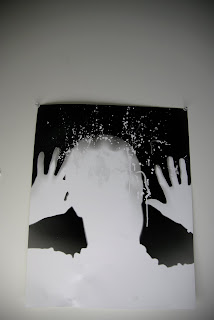
READING: Framing the American Landscape by Car
The New Yorker magazine and the New York Times recently published reviews of the Lee Friendlander's "America By Car" exhibit at the Whitney Museum. How do the reviews compare? Is using the car window a gimmick? Do you like the images?
How does Friedlander's work compare to Oscar Fernando Gomez (a younger Mexican photographer)?
INFO: Pier 24 Gallery
Pier 24 is another photography gallery to visit in San Francisco. This one is by appointment only, but it looks like a terrific place to check out in the future.
Thursday, September 2, 2010
DARKROOM PROJECT
Students are getting reacquainted with the darkroom by:
- Using the big enlargers to make large prints
- Comparing fiber and RC photo papers
- Experimenting with head, upper torso, and full body photograms
Starting the 2010-11 class year
Our Advanced Photo Class is just getting started. I've asked each student to post something to this blog to make sure their account is working. So let's see if everyone can just say hello here in response to my post. Thanks!
